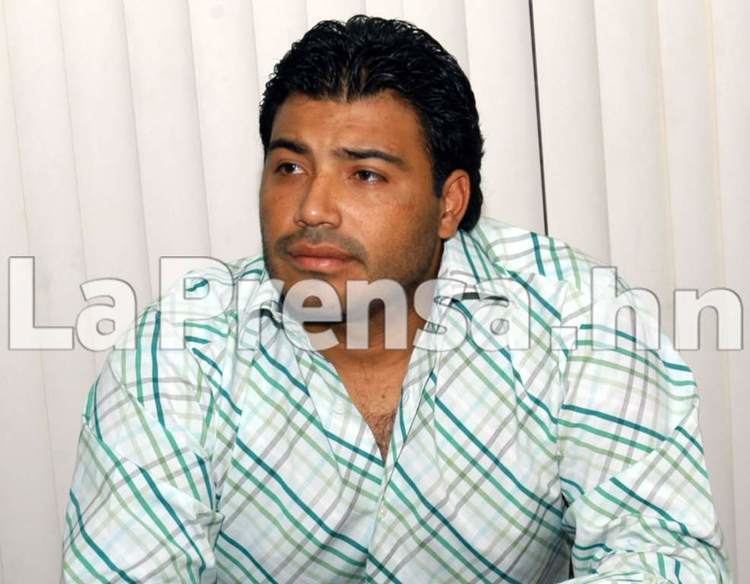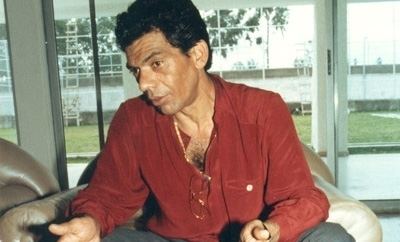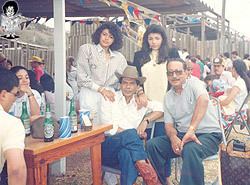Nationality Honduran Name Juan Matta-Ballesteros Spouse(s) Nancy de Matta | Criminal status Incarcerated Other names El Negro | |
 | ||
Children Claudia Matta, Juan Ramon Matta, Maria Matta Similar People Kiki Camarena, Miguel Angel Felix Gallardo, Rafael Caro Quintero, Ernesto Fonseca Carrillo, Policarpo Paz Garcia | ||
Fugitivos Episodio 08 Juan Matta Ballesteros HD 720p audio latino
Juan Ramón Matta-Ballesteros (born on January 12, 1945) (also spelled Mata-Ballesteros) was a major narcotics trafficker who has been credited with being one of the first to connect Mexican drug traffickers with the Colombian cocaine cartels. This connection paved the way for a major increase in the amount of cocaine smuggled into the United States during the late 70s and throughout the 1980s. Matta was indicted for operating several major cocaine smuggling rings in United States in the early 1980s. He was also one of the narcotics traffickers accused of the kidnap and assassination of American DEA agent Enrique Camarena in 1985.
Contents
- Fugitivos Episodio 08 Juan Matta Ballesteros HD 720p audio latino
- Early career
- 1980s Drug U S Smuggling Operations and Indictments
- Involvement in Camarena Kidnap Murder
- Arrest and removal to US
- Conviction and incarceration
- Mattas Role in the Guadalajara cartel
- Matta Ballesteros and the Contras
- References

In 1988 Mata was abducted from his Honduran residence in a controversial operation by the Honduran and American governments and taken to the United States, where he stood several trials for his drug smuggling activities and his part in the kidnap and murder of Enrique Camarena. He was found guilty of drug smuggling, and of participating in the kidnapping, but not the murder, of Camarena. Matta is currently serving multiple life sentences at the United States Penitentiary, Canaan, a high-security federal prison in Pennsylvania.

Early career

Details of Matta's early life and career are uncertain. According to a website put up by his family, he was born in Tegucigalpa, the second of four children. A number of newspaper sources claim that Mata immigrated illegally to the United States as a teenager and was deported several times, returning each time under a different name. In 1970 he was convicted of entering the country on a false passport and confined at the Federal prison camp in Eglin, Florida. He escaped from the camp the following year. In 1974 Mexican authorities arrested Matta for selling 10 kilos of cocaine. He spent a year in prison, and was suspected of killing two other prisoners while incarcerated.
1980s Drug U. S. Smuggling Operations and Indictments

In the early 1980s, Matta was involved with major cocaine smuggling operations. In 1984, he was indicted for his role in a Van Nuys smuggling ring. The discovery of the ring in 1981 resulted in the seizure of 114 pounds of cocaine and $1.9 million in cash, and based on ledgers found with the drugs, prosecutors later estimated that the ring had generated $73 million in just nine months. In 1985, Matta was again indicted for his role in a major cocaine smuggling ring operating in Arizona and southern California. The ring was discovered in 1984, resulting in the seizure of about a ton of cocaine and $7.8 million in cash.
Involvement in Camarena Kidnap-Murder

Soon after the February 1985 kidnap-murder of U.S. DEA agent Enrique Camarena, Matta was suspected of involvement, and he was later indicted for his part in the kidnapping. According to writer Elaine Shannon, Matta was actually located in Mexico City several days after Caramena's kidnapping, but his arrest was delayed by Mexican authorities and he managed to flee the country. U. S. law enforcement continued to track Matta, and in April 1985, they traced him to the Colombian city of Cartagena. At the DEA's request, Matta was arrested by the Colombian government. In March 1986, while extradition proceedings were still underway, Matta escaped from prison, according to some accounts by bribing prison authorities. Later that year, Matta returned to his native country of Honduras.
Arrest and removal to U.S.

The Honduran Constitution prohibited the extradition of Honduran citizens, and for two years Honduran authorities rejected U.S. requests to extradite Matta. Finally, in April 1988, Honduran police arrested Matta and put him on a plane to the Dominican Republic. The Dominican government then put him on a flight to Puerto Rico with United States Marshals who arrested Matta when they reached United States territory. The day after Matta's extradition, 1,000 to 2,000 students from the National Autonomous University in Tegucigalpa marched on the U.S. embassy to protest. During the protests, which lasted for two days, the embassy was set on fire, and five students were killed.
Conviction and incarceration
Like other notable players in the Camarena case, like Rafael Caro Quintero, Ernesto Fonseca Carrillo and Miguel Angel Felix Gallardo before him, Matta was eventually convicted as one of the masterminds behind the 1985 kidnapping, torture and murder of U.S. DEA Agent Enrique Camarena in Guadalajara, Mexico. Further, Matta was later convicted for operating an importation and cocaine distribution ring into Van Nuys, California.
Matta appealed his conviction several times. Finally, in 1995, the U.S. Court of Appeals for the Ninth Circuit found that the United States Supreme Court, in a 1992 ruling on another defendant in the same case, had upheld the prosecution of a fugitive who was brought to the United States by kidnapping rather than extradition.
Matta also appealed on the grounds that he was beaten and burned with an electric stun gun while being transported to the United States. A Federal judge in Los Angeles had previously found the evidence for his claims inconclusive, and the Court of Appeals declined to overturn that ruling.
Matta is currently being held at the United States Penitentiary, Canaan, a high-security federal prison in Pennsylvania.
Matta's Role in the Guadalajara cartel
Several writers have claimed that Matta played an important role in the formation of the Guadalajara Cartel, brokering some of the earliest deals between Colombian cocaine suppliers and Mexico-based smugglers, and starting Mexican smugglers in the business of transporting Colombian cocaine into the U.S. By 1975, Matta had formed an alliance with the Mexican smuggler Miguel Ángel Félix Gallardo, and with them the Guadalajara Cartel began to take shape.
By the late 1980s, Matta had become extremely wealthy and employed thousands of people in the businesses he owned. Matta also possessed investments in coffee, tobacco, spice, cattle, and dairy operations and founded several agricultural and construction firms in Honduras. A U.S. court of appeals estimated that Matta and Felix Gallardo were pulling in more than $5 million per week from their drug trafficking activity alone, and these businesses helped Matta launder much of these illicit earnings. In 1982, DEA agents reported that Matta had paid $50 million to Bolivian and other Latin American officials to protect his narcotics operations from law enforcement harassment.
Matta-Ballesteros and the Contras
A United States Senate investigation found that an air transport company controlled by Matta was used by the U. S. government to supply the anti-government Contra rebels in Nicaragua. According to the Kerry Committee report, the Honduran airline SETCO was "the principal company used by the Contras in Honduras to transport supplies and personnel for the Honduras-based FDN (one of the earliest Contra groups)], carrying at least a million rounds of ammunition, food, uniforms and other military supplies for the Contras from 1983 to 1985." According to a 1983 U.S. Customs report that the Kerry Committee report cites, “SETCO aviation is a corporation formed by American businessmen who are dealing with Matta and are smuggling narcotics into the United States."
